ADEX 2011 Report
Subal
Subal, one of Austria’s famous housing manufacturers, recently had a structural reorganization. With that behind them, Subal was late getting into the Nikon D7000 game, but they’ve also had time to nitpick on the weaknesses of the competitors. Subal did intend bring out a housing that seems to be a strong challenger to the competition.
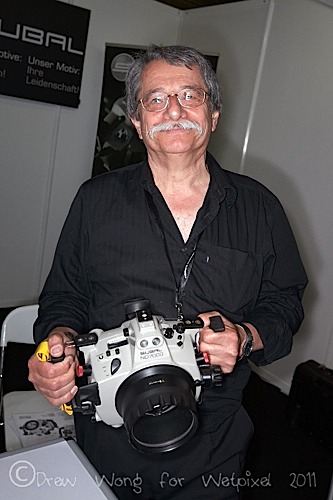
Rolf Sempert shows off the latest Subal housing, the ND7000.
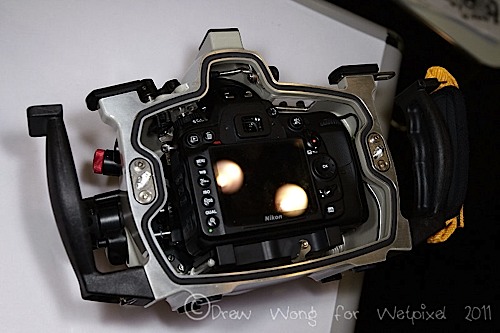
The ND7000 front end with camera inside.
The ND7000 looked like a clean piece of sculpted aluminum. The new features include 2 optical flash sensors, a new prism viewfinder accessory and port and extension ring locking system. In the forums, there’s been chat about how Subal (and other European manufacturers) are losing on cost to brands from other countries like China. Ever interested in topics like that, I asked Rolf to introduce the ND7000 with a demonstration of his housing and port locking system, while touching on the subject of competitiveness of Subal to the other brands, including cost differentials. Not satisfied with just a written report, I interviewed him on video**:
An Interview with Rolf Sempert of Subal from Wetpixel on Vimeo.
My personal view of the ND7000 is that it’s a feature packed, well designed and built housing. Initially, I’d balked at lack of ability to change memory cards without removing the camera, like the Aquatica or Nauticam. Then I realized that the D7000 had dual memory slots so you can actually put in a total of 128GB of SDXC cards. The battery would die out way before memory would run out. With dual slot cameras with small batteries, it isn’t necessary to be able to change cards, unlike the single slot variety like the Canon 7D and 5D2.
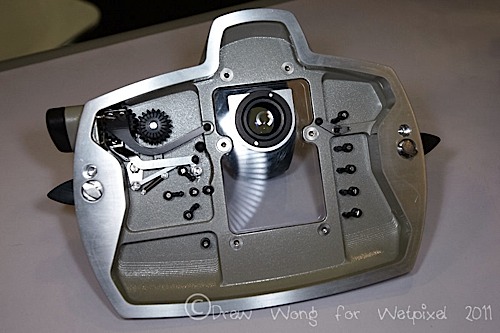
The back cover of the ND7000. Note how uncomplicated the setup is!
Another design feature that grabbed my attention was the very neat layout of the buttons throughout the housing. It’s so clean compared to Nauticam’s almost chaotic rear plate. Obviously the Nauticam housing has more functions put on the back because of the design. Looking at the comparison pic, even for the same functions, the controls look neater and better spaced. The spacing is important for those using gloves in cold water etc. I remember using the Nauticam 7D housing in Africa last year and the buttons were pretty close together and I had a bit of an issue to precision with fat finger gloves.
Another plus with the simple layout is the ability to fix things in the field. The Nauticam 7D used loctite in several places and when the shutter trigger failed to catch properly (among other issues), we had difficulty fixing it because we had no loctite on location. These simple controls on the ND7000 seem to make it easier but only a full field review will be able to tell if it stands up to the other brands.
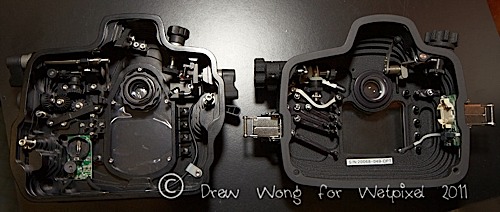
For comparison, the Nauticam (Left) and Aquatica backs for the Nikon D7000
Furthermore, the MSRP of the Subal ND7000 is US$4400, which makes it a lot more expensive than the competition. Being the only manufacturer with a 10” dome and the prism viewfinder which is user changeable (Alex you gotta love that!) makes a good case for the premium, but not for a large portion of market. It’ll be interesting to see in the next year as with the Japanese disaster, all cameras won’t be replaced as quickly and the camera life cycle should be lengthened, if there are no supply issues.
**The interview wasn’t designed to be an exposé on Subal but merely to give Subal a voice on how they can remain competitive in a very tough industry. The interview is shown in entirety with edits for the questions only.
Seacam
Another Austrian company, Seacam was also at ADEX. Harald Hordosch was showing the new Prelude series housings for the Nikon D7000 and the Canon 60D. According to Harald, the Prelude range was designed as an entry level housing, a “baby seacam” if you will, for those looking to get into the Seacam line. There was a little controversy over the lack of controls on the housing in the forums, so I posed those questions to Harald for his views on the issue.
Harald explained how he envisioned the housing to be an entry level housing, which was much lower in price over the regular Silver range but also his first foray into DSLR housings for entry level cameras like the 60D and D7000.
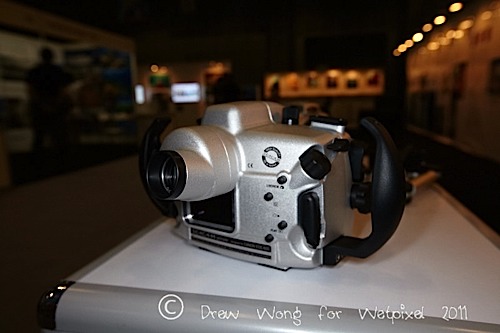
The Prelude 60D for the Canon 60D with the new S10 viewfinder.
In his research phase, Harald worked with professional photographer Kurt Amsler on coming up with a concept of what was needed for a housing built on “doing things differently” and how he wanted the Prelude to work on the “less is more” and keep things simple for the shooter to concentrate on the shooting. To him, this was an entry level housing and not a professional rig. Things like the DEL. ISO and other functions were omitted. His reasoning was that with dual cards and up to 64GB SDXC cards available, no one would delete underwater anymore. The ISO function could be assigned through the menus and since Shutter and Aperture are the main controls for exposure, he did not include a direct control in the housing.
I came away from the interview a bit reticent on what to say. Here was a man who obviously had his ideas about how his products would function in the hands of his clients. As an owner of a Seacam myself, I could see his design philosophy and attention to detail. However, many don’t agree (myself included) with his assessment of the D7000’s capabilities. Yes, it is an entry level camera pricewise, but in the end, the image out of the sensor is what counts and the image from the D7000, in my humble opinion, performs as well as if not better the mid priced cameras in the Nikon range like the D300s and D700. On function alone, it can shoot 1080/24p which leaves the other cameras far behind. By leaving out easy access to exposure controls and other functions, beginner shooters will find it less optimal to grow into the housing as their skills improve. While it is an entry level priced camera, the Seacam Prelude housing is priced in the upper middle of the housings available for the camera.

The Prelude D7000 housing
One also has to consider the accessories Seacam offers, like the new S10 viewfinder, which is cheaper, lighter and smaller than the venerable S180 viewfinder. I looked through the viewfinder and it looked great giving a 100% view of the camera viewfinder. Of course, Seacam has been known for the Superdome and other ports with a full array of port extensions with the screw in mount that I personally found the most secure for the longest time. However, with the other manufacturers offering port locking systems , including extension rings, the gap has closed considerably. Other accessories like the Seaflash, which for Canon users is the only strobe with Rear Curtain(2nd curtain) shutter sync and eTTL function built in. Others have eTTL but not rear curtain. Fair to say though that if the Seacam had optical sensors for strobes, then those functions would be available anyhow.
When I didn’t agree with Harald’s labeling of the D7000, he suggested I review the Prelude Canon 60D housing with the new S10 viewfinder, to see what he means by “less is more!” I always strive to keep an open mind, so I accepted this offer. I’ll be testing it in the tough conditions of the Ocean Safari in June so it’ll be interesting to see how the housing will fare under demanding circumstances.